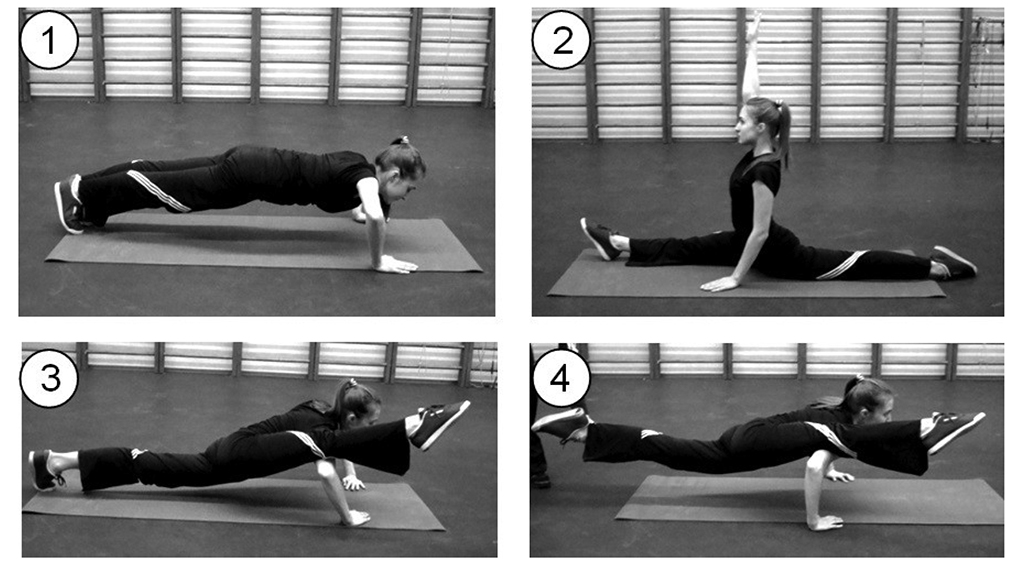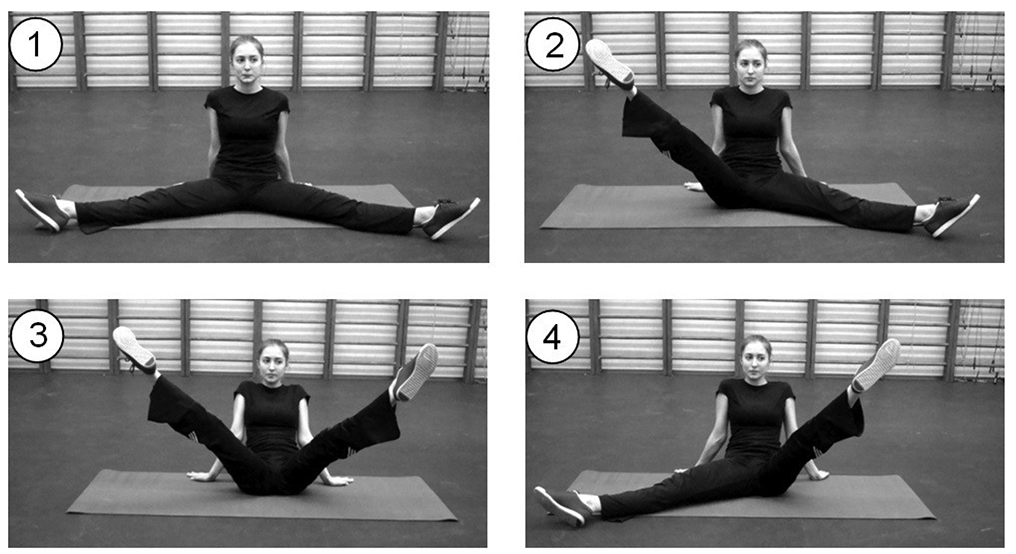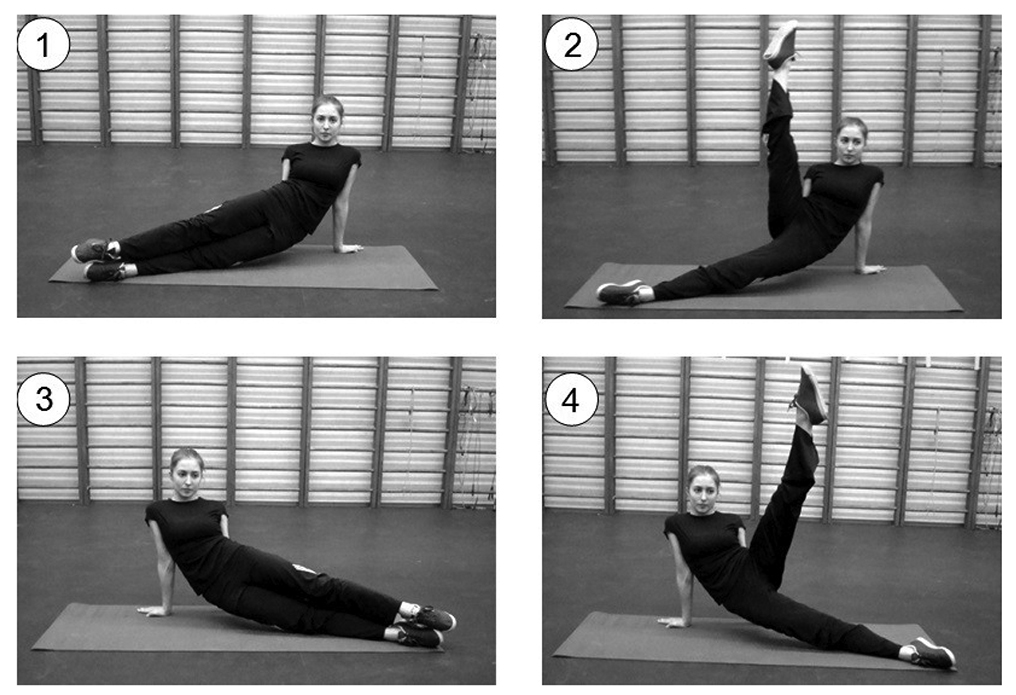Aerobic gymnastics element “Flair”: technique of execution and training method
Фотографии:
ˑ:
Associate Professor S.M. Lukina1
Dr.Hab., Professor A.A. Somkin2
E.A. Zhuzhakova1
O.I. Rozanova1
1St. Petersburg State University, St. Petersburg
2St. Petersburg State Institute of Cinema and Television, St. Petersburg
Keywords: International Gymnastics Federation (FIG), aerobic gymnastics, flair (Thomas), technique of execution, lead-up exercises.
Introduction. Aerobic gymnastics is a modern, faddish, especially among students, kind of sport that emerged in the 1980s:
- firstly, as a blending and further modernization of conditioning gymnastics and rhythmic dancing exercises with a health-improving effect performed to driving music;
- secondly, as a new interpretation of the well- and long known elements of artistic, rhythmic, acrobatic gymnastics and other complex coordination sports.
Various dancing movements, including aerobic ones, had been practiced in the International Gymnastics Federation (FIG) for quite a long period of time. They performed, primarily, a demonstration function and acted as exhibition performances during the World Gymnaestradas - international non-competitive gymfests, "mass physical culture festivals". Therefore, it was quite natural for FIG to start developing within its structure competitive aerobics as "elite" sport. During the 69th FIG Congress, held in Geneva in 1994, most delegates representing their national federations endorsed this proposal. At the Congress, they rendered a decision in principle to hold the 1st Aerobic Gymnastics World Championship in 1995 [5, 8]. For this purpose, the Sports Aerobics Commission was formed, and they prepared the first competition rules, which came into force on April 6, 1995. It was quite natural and expected that, during the rules development, the Commission relied on the old FIG rules in artistic and rhythmic gymnastics competitions [1]. "Aerobic gymnastics" got its name at the 75th FIG Congress in Antalya (Turkey), in 2004.
The structural group of elements - Leg Circle Family - was borrowed from the artistic gymnastics competition rules. The first wording of the sports aerobics competition rules comprised two elements only: a double-leg circle (group D=0.4 points) and a flair (group C=0.3 points) [1]. In gymnastics, flairs were first demonstrated on a pommel horse in the mid 1970s almost simultaneously by Ph. Delasalle (Canada) and K. Thomas (USA). Then the gymnasts began to perform flairs during floor exercises and on parallel bars. Nevertheless, in the FIG competition rules such circles were named after the first performer - Thomas flairs [3]. In the 1980s, female gymnasts began to perform flairs on a balance beam. Soviet gymnast S. Baitova was among the first to do that [4]. In aerobic gymnastics these circles are called flairs and can be performed both in solo compositions (both by males and females) and as part of paired or group programs. Until the mid 2000s, only one element was represented in the aerobic gymnastics competition rules – the flair. However, later this structural group began to develop in the following directions: due to various final positions [6]; half-twists and full twists; the so-called "Spindle"; twist airborne to push up (Pimpa element); the so-called "Air Flair".
In total, the latest wording of the aerobic gymnastics competition rules (2017-2020) comprises 15 elements of the flair structural group, which are scored from 0.5 to 1.0 points [2].
Objective of the study analyze the technique of execution of the "flair" element and develop the training method to be implemented in aerobic gymnastics.
Methods of the study. We conducted a theoretical analysis and generalization of the literary sources and FIG normative documents (competition rules), took photos and videos, used the elements of biomechanical analysis of movements.
Results and discussion. Let us consider the fundamentals of the technique of execution of the flair (Thomas flair) during floor exercises in gymnastics (Figure 1). It is similar to the technique of execution of this circle on other gymnastic apparatus – pommel horse [7], parallel bars, a balance beam. This circle, unlike the double-leg circle, combines the structural features of the horizontal (circles) and vertical (crossing) leg swings [9]. Performance of the Thomas flairs implies practically isolated movements of each leg against the background of the ellipsoid movements of the gymnast’s body. The preparatory position is, as a rule, a push up. When performing a Thomas flair to the right, the gymnast takes a step to the left and then, kicking off and straddling (Fig. 1, Frame 1), shifts the body weight onto his arms. The legs move to the right along different trajectories: the left one - along the circular trajectory; the right one - rises actively to the right and upwards (Figure 1, Frame 2). With the right arm on the support, the right leg is in the vertical position, and the left leg continues to move along the circular trajectory to the left (Figure 1, Frame 3). Leaning back the gymnast, holding the right leg in position, actively raises the left leg, passing the intermediate position of the high straddle angle. In the second half of the Thomas flair the trajectory of the legs movement changes: the right one is lowered and goes over to the elliptical (circular) trajectory; the left one continues to actively rise and hold to the left and upwards. The left leg reaches its highest (vertical) position at the moment of repulsion with the left hand and rapid passage of the right leg right under it (Figure 1, Frame 4). After this, the left arm is placed on the support and the left leg is lowered to the horizontal position (Figure 1, Frame 5).

Fig. 1. Thomas flair performed during floor exercises in artistic gymnastics [3]
The flair execution technique in aerobic gymnastics is almost completely the same as described above - both for males and females. Only the final positions can differ: push up (Figure 2, Frame 1); split (Picture 2, Frame 2); Wenson (Figure 2, Frame 3); lifted Wenson (Figure 2, Frame 4).
After analyzing the flair execution technique, we developed a training sequence, where the first step comprised a set of lead-up exercises used to master individual phases of this circle and raise the level of special physical fitness. We give a description of the main lead-up exercises that must be included in the athletic training (of both males and females), who consider the possibility of learning the flair and including it or more complex elements of this structural group in the compositions performed.

Fig. 2. Final positions of the flair:
1 – push up; 2 – split;
3 – Wenson; 4 – lifted Wenson.
1. Preparatory position - push up at chest height from the gymnastic wall. Accented alternate sideways leg swings with a short-term (if possible) fixation at the top of the swing.
2. Preparatory position (PP) - kneeling. Kicking off to a straddle-planche (short-term fixation) and return to the PP.
3. PP – rear support in saddle, legs apart. Lifting the legs and the pelvis from the support, high straddle angle (short-term fixation) and return to the PP.
4. PP - rear support in saddle (Figure 3, Frame 1). The right leg sideway swing (Figure 3, Frame 2). Holding the right leg in position, the left leg sideway swing (Figure 3, Frame 3). Holding the left leg in position, the right leg is lowered (Fig. 3, Frame 4). Then the left leg is lowered. Return to the PP (Figure 3, Frame 1).
5. PP – left side leaning support with the arms behind (Figure 4, Frame 1). Accented right leg swings to the side and upwards with a short-term fixation at the top point (Figure 4, Frame 2). PP - right side leaning support with the arms behind (Figure 4, Frame 3). Accented left leg swings to the side and upwards with a short-term fixation at the top point (Figure 4, Frame 4).

Fig. 3. Flair lead-up exercises (4)

Fig. 4. Flair lead-up exercises (5)
Flair training is to preserve integrity. The first step a trainer should make is to "guide" the athlete's legs by holding him by the thighs, along the whole trajectory with the fixation in the "key" points of the movement. Then follows individual execution of the flair on the auxiliary gymnastic apparatus - floor mushroom. The final step is the execution of the flair under standard conditions on the aerobic gymnastics competition ground.
Conclusion. The flair element combines the structural signs of the technique of simultaneous horizontal and vertical leg swings. We developed the flair training method, the first stage of which was a set of lead-up exercises aimed at both mastering of individual circle phases and raising the level of special physical fitness of athletes. The final stage of the method consisted in the execution of the flair under standard conditions on the aerobic gymnastics competition ground.
References
- 1994–1996 Code of Points. Sports Aerobics. FIG, 1995, 20 p.
- 2017–2020 Code of Points. Aerobic Gymnastics. Appendix II. Guide to Judging Execution and Difficulty. FIG, 2016, 67 p.
- 2017–2020 Code of Points. Men’s Artistic Gymnastics. FIG, 2017, 159 p.
- 2017–2020 Code of Points. Women’s Artistic Gymnastics. FIG, 2017, 221 p.
- Guilbert K. (1995) Sports Aerobics Enters the World Stage. World of Gymnastics, October, no.16, pp. 15–17.
- Kwang Xiaohong, Wang Pei & Zhang Peng (2014). Innovational Research of Aerobics Gymnastics’ New Difficulty – Explosive A–Frame ½ Turn to Flair to Wenson. Proc. Scientific Research in Aerobic Gymnastics. Summary 2010–2014. 1st Edition. FIG, Р. 64.
- Prassas S., Ariel G., Ostarello J. & Tsarouchas E. Thomas Flairs on the Pommel and Floor: a Case Study, Proc. XXIV International Symposium on Biomechanical in Sport (Salzburg, Austria, 15 July 2006). 2006. Р. 1.
- Titov Y. (1995). Editorial. World of Gymnastics. February, no. 14, Р. 5.
- Watanabe M. (1998). Basic Swing. Technical Concept. Technique, vol. 18, no. 2, pp. 10–14.
Corresponding author: svetlanaueg@rambler.ru
Abstract
Rules of competitions of International Federation of Gymnastics for aerobic gymnastics in the period of 2017–2020 include a group of 15 “double-leg circle” elements. Objective of the study was to consider the core “Thomas flair” execution technique. The authors have theoretically analysed and generalised the available study reports and regulatory provisions (including the rules of competitions) by the International Federation of Gymnastics, studied the relevant photo- and video-captures and made an elementary biomechanical analyses of the movement sequences.
Based on the technical analyses, the study offers a special training procedure to master the element, with a special emphasis on a set of lead-up exercises designed to help master the Thomas flair technique and improve the special physical fitness of the athletes at the same time.



